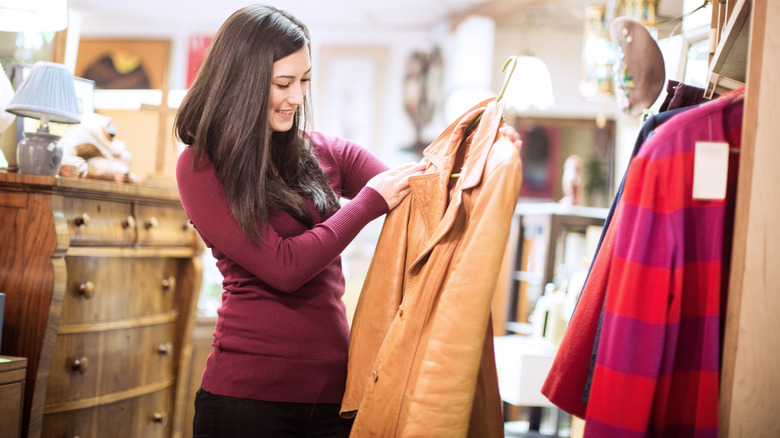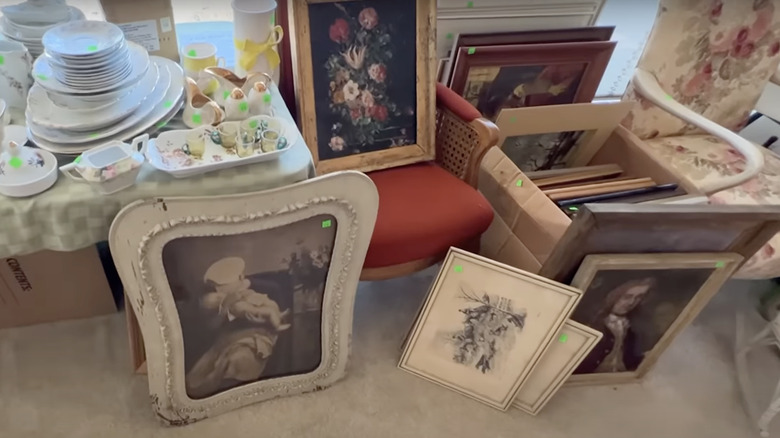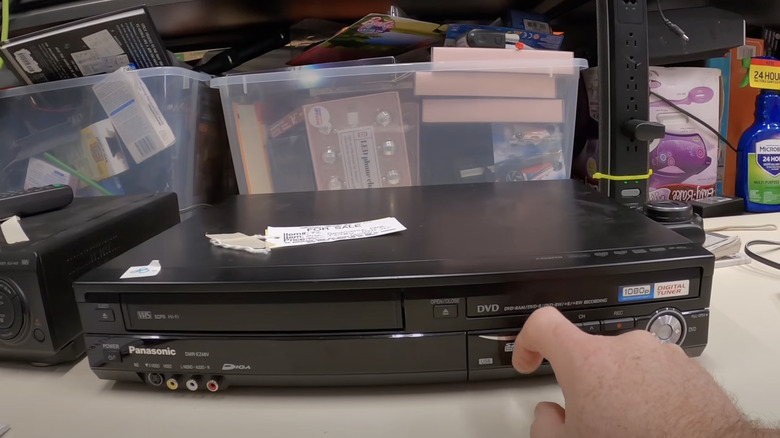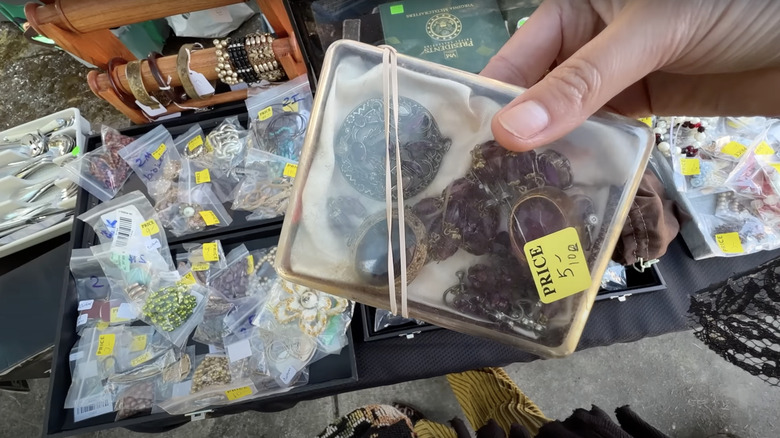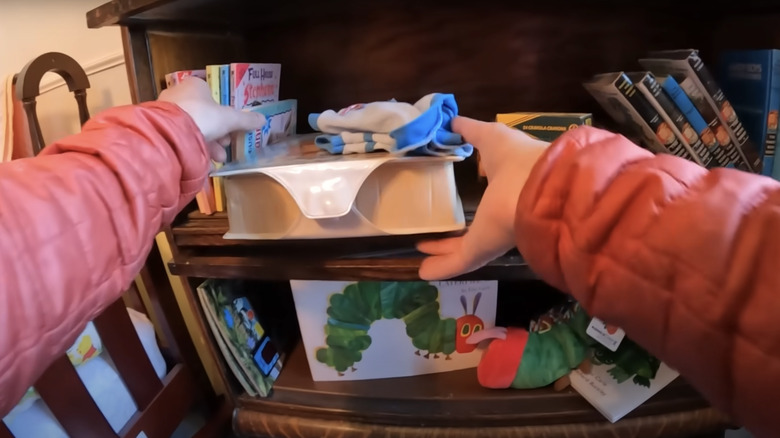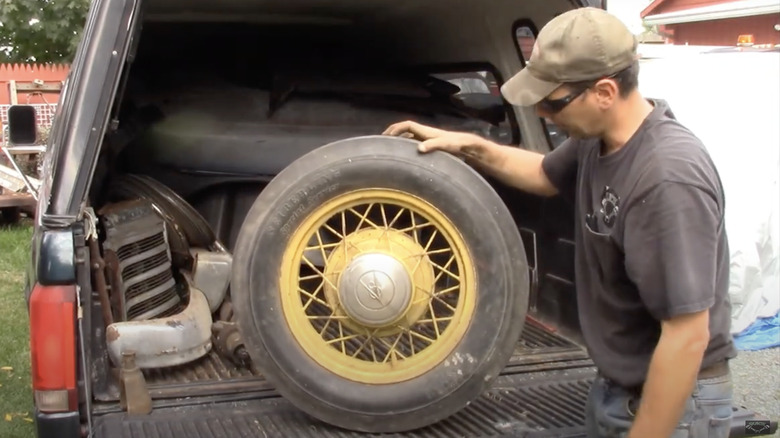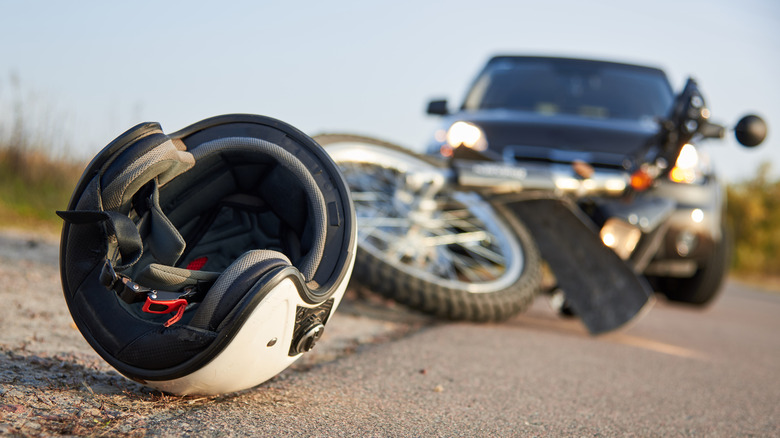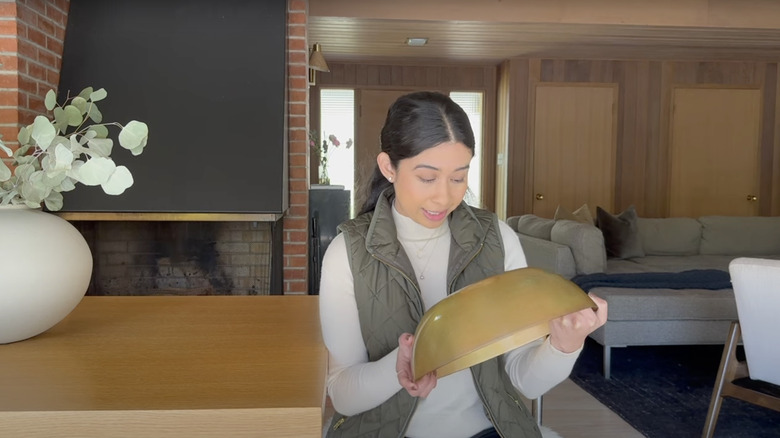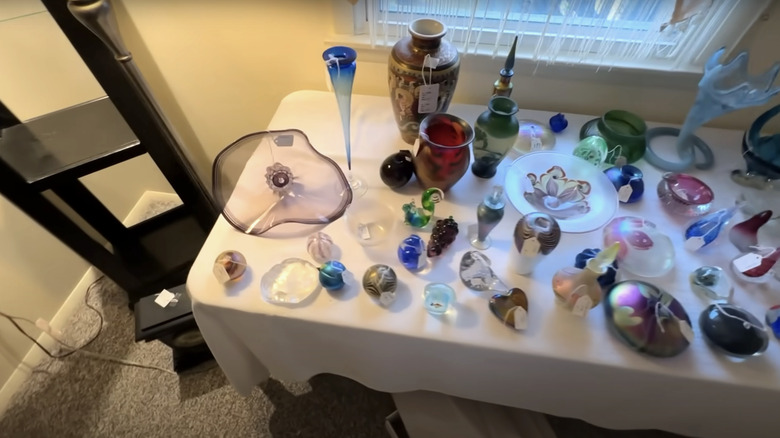The Biggest Rip-Offs To Avoid Buying At An Estate Sale
Estate sales are essentially massive garage sales with thousands of items listed for purchase. These events are organized after homeowners get evicted, pass away, or downsize to new homes. In these circumstances, people don't typically keep their belongings, leaving behind the things they and their families don't see a reason to keep. As the saying goes— one man's trash is another man's treasure. However, what you might initially discern as treasure could be a deceptive rip-off in disguise.
When homeowners leave quickly, something must be done with the items that were left behind. Auctioneers or estate sales professionals assume responsibility for pricing and organizing the leftover items for public perusal, hoping others will find value in the abandoned goods. These items can include furniture, artwork, equipment, and other personal belongings, giving hopeful bargain hunters plenty of products to scrounge through. While some estate sales have great deals hiding behind their doors, all purchases aren't guaranteed to be in your favor. With great reward also comes great risk, and there are many items you should avoid unless you're an adept appraiser. Learn more below about items you should be wary of and how to avoid making regrettable purchases at estate sales.
Fraudulent and overvalued artwork disguised by pretty frames
One of the most common sights at estate sales is classic-style paintings hung in elaborate frames. It's easy to assume these items have value, especially if you're fascinated by the image portrayed. No matter how much the painting appeals to you, don't fall for ridiculously high prices.
Mass-produced, standard-sized paintings shouldn't cost more than $50, based on fair market value. If you come across artwork priced higher than that, be wary before purchasing. The estate sale company may be hoping a higher price will make a painting seem worth more than it is. It may be a valuable painting from a well-known artist, but unless you're a skilled art appraiser, you're unlikely to be able to identify its authenticity confidently.
Frames can also indicate artwork's worth. Cathy Purple Cherry, a professional architect, told Veranda.com to "Flip artwork over to examine the professionalism of the framing," to see if the framing is causing the high price. If it's been permanently framed and sealed by a reputable shop, the frame itself may be worth the higher price. It's also more likely that the artwork is valued highly since most people wouldn't frame a worthless art piece.
Untested and possibly broken electronics and appliances
Vintage and modern electronics are also popular estate sale finds, whether it's the newest Playstation console or an outdated 1970s VCR player. No matter how old or new the item appears, be wary before investing in either one for its working quality. Unless the seller allows you to plug it in and test it out, you could make a worthless purchase. This advice goes for electronic devices of all kinds: game systems, televisions, stereos, phones, kitchen appliances, electric tools, watches, computers, printers, and more.
Unlike online and in-person retailers, real estate sales don't typically offer refunds or warranties on defunct products. Before jumping to conclusions as to why broken electronics are often found in estate sales, remember that the organizers aren't necessarily selling broken devices for nefarious reasons. More likely, they had thousands of other items to list and tag and didn't have time to test every electronic on site. It's not the auctioneer or professional estate sale agent's job to ensure their customers make good purchases.
Overpriced jewelry that you can't confirm is authentic
When you buy jewelry from a certified jeweler, you're purchasing a product that has been appraised based on its condition, build, quality, rarity, and historic value. In contrast, the people running an estate sale may not have the knowledge or time to evaluate every piece of jewelry put up for sale. Therefore, their "vintage" rings, bracelets, and necklaces could be authentic pieces worth thousands or simply cheap imitations of the real thing.
Before committing to a gorgeous but expensive gemstone, teach yourself how to spot pieces that are actually worth their listed prices. Look for markings on the backings, clasps, insides, and backsides of the piece in question. There should be a tiny engravement that names the brand, designer, and what type of material it is. Also, look for scratches or other signs of damage that may reveal the item is only fake silver or gold-plated, and is actually a completely different metal underneath. Memphis Gold and Diamond Buyers has an in-depth online guide to help discern between costume and real jewelry.
Vintage baby toys and accessories dated before the 1970's
Having a baby isn't cheap, and estate sales can be very enticing for new parents with a penchant for thrift shopping and obtaining vintage wares. Don't fall for the nostalgia of retro toys or the eclectic quality of an outdated crib set. Despite how cute and classic these items appear, they aren't guaranteed to meet modern-day standards and regulations. Past furniture and toy designs are often recalled due to having choking hazards or being coated in dangerous chemicals like lead.
Like with the aforementioned electronics, it's not the estate sale organizer's job to ensure baby items are up to today's criteria. While a stroller or dollhouse may look like they're in decent condition from the outside, they may not be structurally sound and pose a danger to children. For all you know, these items were left behind because the previous owner saw no reason to pass them down in their family or to bring the items with them. Maybe it was too old or overused, and they didn't want to risk trying to use it beyond its lifespan. If you're a parent, leave the vintage toys for adult collectors and pass on this investment that could endanger your household.
Tires and car parts that were formerly used or altered
Although cheap, used car parts seem like a great value, there is always the gamble of accidentally purchasing compromised items. Tires and other automobile components are more complex than they seem. Their interior elements could be weakened, therefore making them dangerous to attach to your vehicle.
Old tires or car parts can look like they're in decent condition from the outside, but there is no way to determine their age or how long they've been locked up in storage. Simply put, you don't know how functional or safe the item is. Estate sales differ greatly from reputable used auto part stores, which often offer warranties or refunds if you purchase malfunctioning pieces. These locations also test their parts before selling them, making them far more reliable than real estate sales. As previously discussed, auctioneers and estate sale agents do not have time or reasonable purpose to evaluate individual working car parts and tires. They'd rather sell them all at a significant discount to curious buyers, leaving it to the consumer to decide whether or not to risk the purchase.
Helmets and other safety equipment that are no longer under warranty
Estate sales carry helmets of all kinds, from simple half-shell styles that shield the top of your head to full-face designs that wrap around your entire head and neck. Whether you're buying a helmet for casual cycling or racing dirt bikes, purchasing from an estate sale is not a safe move. A helmet's outer shell may be in great condition, but it does not guarantee that the inner shell is equally sound.
When agents set up estate sales, they don't learn the histories behind every listed object. Only the home's original owner knows what trauma their old helmets have been through, and those individuals are often absent from these large-scale auctions. According to FortaMoto, a motorcyclist shop, polycarbonate helmets last about four years, while composite helmets last between six to seven years. These statistics reveal that even the best materials have short lifespans. This company also describes helmets as "disposable products," explaining they should be thrown away after befalling trauma. Since you don't know how often a helmet has been dropped, it's better to leave it on the table and save money by buying less compromising equipment.
Knockoff furniture and other items
Any furniture or decorative item labeled "Inspired by-" should set off immediate alarm bells in your head. Auctioneers sell these knockoff pieces at very high price points under the guise of being identical to authentic vintage handiwork. If you're unlucky enough to have stumbled into an unethical estate seller's domain, the furniture may even be falsely advertised as a true antique.
Avoid this trap by knowing how to spot truly authentic furniture. Don't look for telltale signs of aging since many modern furniture makers deliberately create cracks, add patina to metal, or darken wood to emulate an older look. Instead, search for modern characteristics and materials. Polyester, plywood, and particle board were not used until after the 1920s, invalidating any items claimed to be made before that time. Mixed woods, square nails, and rough hand-carved feet are also common characteristics of authentic pre-20th-century products. Porcelain products may have originally been genuine, but once they're restored, they lose their antique value. Remember, it's okay to purchase goods that aren't hundreds of years old, just make sure you aren't overpaying with the misconception you're buying a one-of-a-kind, centuries-old piece.
Modern items sold close to their retail price
While many estate sale enthusiasts are driven by their love of antiques, many people also find joy in modern and well-known brands. The beauty of modern-day brands is that they often sport the company logo or name, making their products easy to identify. However, never assume you're getting a great discount because you found a gently used brand-name product.
Estate sales are notorious for listing these items at a slight discount below their original price. Luckily, online sources are highly accessible due to smartphones. Don't be afraid to do a quick Google search or snap a photo for a reverse image search to see how much a product is sold for brand new. If you're lucky, there may be other used online listings that you can compare to and perhaps barter the selling price to a more reasonable amount.
Generally, secondhand items should be priced at most 80% of the original price. This percentage should go down based on the amount of visible wear and tear. For example, Potterybarn's largest Chesterfield upholstered sofa model goes for $4,399 brand new. Using the 80% rule, you shouldn't settle for any exchange above $3,500 for this sofa, even if you find it used but in perfect shape.
Items you can easily find on FB Marketplace or similar platforms
Modern bargain hunters are truly blessed to have constant and immediate access to online resources. Do diligent research as you scour an estate sale, using your mobile phone to compare prices to common online markets like Facebook Marketplace, eBay, and Craigslist. While estate sales sometimes have one-of-a-kind furniture pieces, gorgeous antique jewelry, or hard-to-come-by nostalgic items, many seemingly good finds are also online for a much lower price.
Estate sales aren't directly competing with other sellers, as they're at their own location and usually not in close proximity to any other estate sales. In contrast, sellers on Facebook Marketplace and other sites have directly compete with other listings. This keeps prices low and competitive, making it easier to find surprising deals on niche products.
The next time you come across a gorgeous $800 coffee table at an estate sale, stop and think before you buy. Do a quick search online for coffee tables with a similar description. You'd be surprised how many free and heavily discounted tables you can find from people desperately trying to get rid of their old things.
